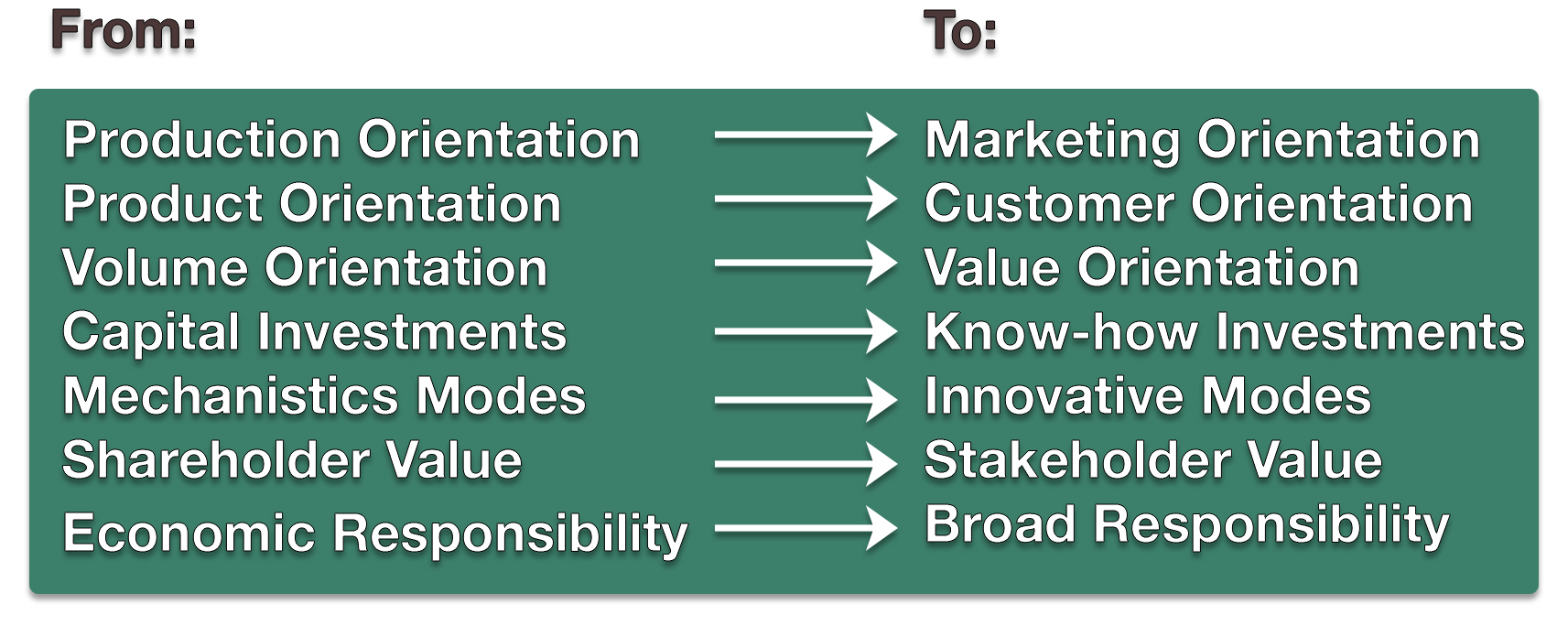1.3 The Evolution of Marketing
After reading this section, students should be able to …
- Explain how and why marketing has evolved over time.
The science called marketing has evolved from a series of other behavioral sciences including psychology, social psychology, sociology, communications, and economics. While it may seem simple to define, the term “marketing” is both broad and complex, with many possible interpretations. As the field of marketing develops, so does its definition. Early definitions were centered on the concept of the transaction, while today, definitions of marketing typically involve relationships, and elements of social and environmental responsibility.
University students, industry managers and ordinary consumers often have a narrow understanding of the concept of marketing. Typically, marketing is associated with its most visible functions, such as advertising and selling. However, advertising and selling are merely tools of marketing. A simple definition of marketing is identifying and providing for the needs of customers in order to gain a profit.
How marketing is executed and the role it plays in an organization depends on the marketing philosophy and culture of a company. An inappropriate or obsolete marketing philosophy often means inappropriate or obsolete marketing actions and weak performance for the company. When marketing is purely a selling function, the company is probably production-oriented. Marketing as an integrator or relationship-builder implies a sophisticated market orientation.
Marketing philosophies have changed in response to historical developments in society. During the early years of modern industries and mass production, demand for products was typically high and it was unnecessary to invest resources into developing demand. Marketing philosophy developed accordingly and was largely production-oriented. Recent developments in the marketplace have forced companies to increase their marketing sophistication by shifting from a production orientation to market orientation (Figure 2-3). With this shift comes a series of more sophisticated approaches to marketing, such as an emphasis on social – rather than just economic – responsibility. Today, a focus on the future bioeconomy has heightened interest in options to fossil fuel-based products. Accordingly, forest industry must respond to this customer interest through its production and marketing, thus potentially leading to an “environmental” orientation.
1.3.1 Production and Sales Orientation
Production-oriented companies concentrate on producing large volumes of commodities at low costs and rely on the sales department to move product into the marketplace. This approach to business works well when demand is high, needs of customers are simple, and competition is limited. The following aspects characterize a production, or sales, orientation:
- Technology and raw materials dominate business thinking
- Product development is concentrated on technological possibilities or better utilization of raw materials
- Planning engineers think they know best what customers need
- Products are commodities
- There are few marketing personnel
- Products are marketed through intermediaries
- Little is known about end-users and consumers
- The cure for demand problems is harder selling
- Salespeople are to blame if the product is not selling
A production-oriented company feels that a marketing department is only a cost-creator between the mill and the market. Under this model, low costs (and thus, low prices) are necessary for success.
Some argue that the marketing philosophy of an industry sector is tied to its particular characteristics (e.g., raw material, production, product). An old saw miller may say, for instance, “only lumber can be sawn out of a log and this can’t be helped by any kind of marketing planning.” However, industry experience suggests that instead of being dependent upon the characteristics of the sector, an appropriate marketing philosophy is more dependent on the dynamics of the industry, the marketing environment, and the innovativeness of the marketers’ attitudes.

As the marketplace changes over time (especially with respect to customer needs and competitors) companies must become more sophisticated in their approach to marketing. A market orientation is seen as a response to ever increasing demands from the marketplace.
1.3.2 Market Orientation
The terms customer orientation and market orientation are similar, but not synonymous. A truly market-oriented business uses marketing as a leading, integrative function which drives all other activities in the organization toward the goal of creating customer satisfaction and value.
In a market oriented company, the customer is raised to a higher status – the “customer is king.” This change in status comes from a realization that profits are created through customers’ needs and buying behavior. In a market oriented company, relationships with end-users are strong and marketing research is conducted continuously. Product development is based on research and marketing operations are planned according to customers’ reactions. A market orientation must be present on all levels of the company and in all marketing planning decisions. In addition, markets and marketing strategies direct business planning, on all levels – investments, production, raw material procurement, etc. The following list overviews how the various aspects of marketing are impacted by a market orientation.
Products – Adopting a market orientation means moving from commodities to special and custom-made products. A paper mill is not producing paper, but rather solutions for different printing tasks and problems. A sawmill is not producing sawn wood, but components for industrial customers. Customers – A market orientation means selectivity in choosing customers. This means choosing the right customer for the company’s product, or choosing the right product for the company’s customer. Market Areas – Understanding markets and customers is a vital capability for a market oriented company. Because resources are limited, the necessary level of understanding can often be reached only for a limited number of market areas. Core competencies – A market oriented company should pay special attention to market intelligence, customer relationships and marketing skills. It should overcome its competitors when creating attractive solutions to the needs of the customers. Organization – Every person in a market oriented company realizes that the company exists for its customers. The “voice” of the customer must be heard throughout the organization. Information Systems – Systems for gathering and analyzing information must be able to produce dedicated customer and market information. For example, each customer’s level of profitability to the company can be assessed using the right information system, and this knowledge can be valuable in allocating marketing resources. Planning Systems – An appropriate planning system is able to use market information in planning of marketing strategies and functions as well as in planning of production and raw material procurement. Marketing Channels – The marketing channels of a market oriented company must form connections to the customer, and information and influence should move freely in both directions. Although the forest industry has made great strides toward market orientation, research shows that there is considerable opportunity for increased marketing sophistication.
Source:
1.3 The Evolution of Marketing is edited and adapted from ‘Chapter 2: Understanding Forest Products Marketing’ from the textbook ‘Strategic Marketing in the Global Forest Industries – Third Edition,’ authored by Eric Hansen & Heikki Juslin, 2018 – this book was licensed under a Creative Commons Attribution-NonCommercial 4.0 International License.


